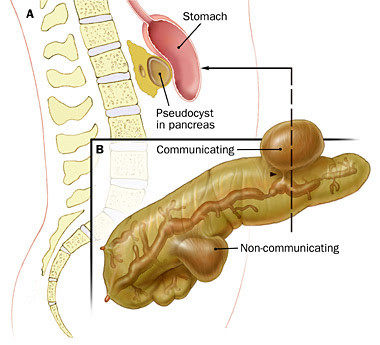The pancreas is essential in the production of enzymes and hormones which help with the digestion of food. If the pancreas becomes damaged, cysts filled with fluid may appear inside or on the pancreas. These cysts are benign and in this instance, they are not in fact cysts at all, which is why they are known as a pancreatic pseudocyst.
What Is Pancreatic Pseudocyst?
As mentioned, a pseudocyst on the pancreas forms when the pancreas is damaged, leading to the leakage of pancreatic fluid, which proceeds to form fluid filled cysts. Conditions such as chronic or acute pancreatitis may lead to the development of cysts, even months after a chronic or an acute pancreatitis attack.

What Are the Symptoms of Pancreatic Pseudocyst?
The most common symptoms associated with pancreatic pseudocyst are pain in the abdominal area and bloating. You may or may not also experience one or more of the following symptoms:
- Fever
- Nausea
- Vomiting
- Diarrhea
- Loss of appetite
- Weight loss
- Tender abdominal mass
- Jaundice (yellowing of the skin/eyes)
- A build-up of fluid within the abdominal cavity
If you do notice that you have one or more of these symptoms, then you should pay a visit to a health care professional, so they are able to determine the cause and the best course of treatment.
What Are the Complications of Pancreatic Pseudocyst?
Although it is a rare occurrence, further complications may arise from the appearance of pancreatic pseudocysts. These complications include:
- Infection – This may also lead to pancreatic abscess on some occasions.
- Pseudocyst rupture – If the pseudocyst ruptures, or breaks open, then it can be life-threatening. This may also happen without warning.
- Biliary complications – This occurs when the pseudocyst is blocking the bile duct, and can lead to jaundice.
- Portal hypertension – Defined as high blood pressure in the portal vein/splenic vein, this requires medical attention (surgery).
How to Diagnose Pancreatic Pseudocyst
Pseudocyst are diagnosed mainly via a CT scan, which is capable of detecting cysts and masses within your body in great detail, helping to best determine what is truly going on inside your body. Other tests that may be used for diagnosis the problem include:
- Blood tests – Tests for pancreatic enzymes, such as lipase or amylase, within the blood. High levels of such enzymes may be an indication of pancreatic inflammation.
- Ultrasound – Also known as a sonography, this test uses sound waves of a high frequency to project an image of the inside of the body.
- Endoscopic Retrograde Cholangiopancreatography (ERCP) – This procedure involves the use of an X-ray and endoscope. The endoscope (a long, clear tube) is guided down the throat of the patient to get a clear picture of digestive organs as it travels through the stomach and small intestine. This can be performed to check for pancreatic problems, including pancreatic pseudocyst.
How to Treat Pancreatic Pseudocyst
In most cases, if the pseudocyst is not causing any symptoms, blocking vital areas of the body, or getting too large, no treatment will be advised. It would be best, in these instances, to see if the pseudocyst shrinks and resolves itself. The rate at which it is shrinking (or growing) will likely be monitored via consistent imagery examinations (CT scans/ultrasound).
If the pseudocyst begins to block organs or gains vastness in size to a point where it may be close to rupturing, then drainage of the pseudocyst may be required. This procedure would involve a surgical incision, either guided by imaging or via a large incision so the surgeon can directly view the pseudocyst. The procedure is performed under general anaesthesia, meaning you will be unconscious during the operation. The contents will be drained and some of them will be kept for lab testing to check for signs of bacteria which could lead to infection, as well as cancer. You will likely be prescribed antibiotic medication to prevent the development of an infection.
Can Pancreatic Pseudocyst Be Prevented?
Pancreatic pseudocyst is most often caused by pancreatitis, meaning preventing the latter is the best way to prevent the former. This means cutting down or stopping your alcohol consumption, as well as lowering your cholesterol intake, instead, taking more fruit, vegetables and lean protein.
